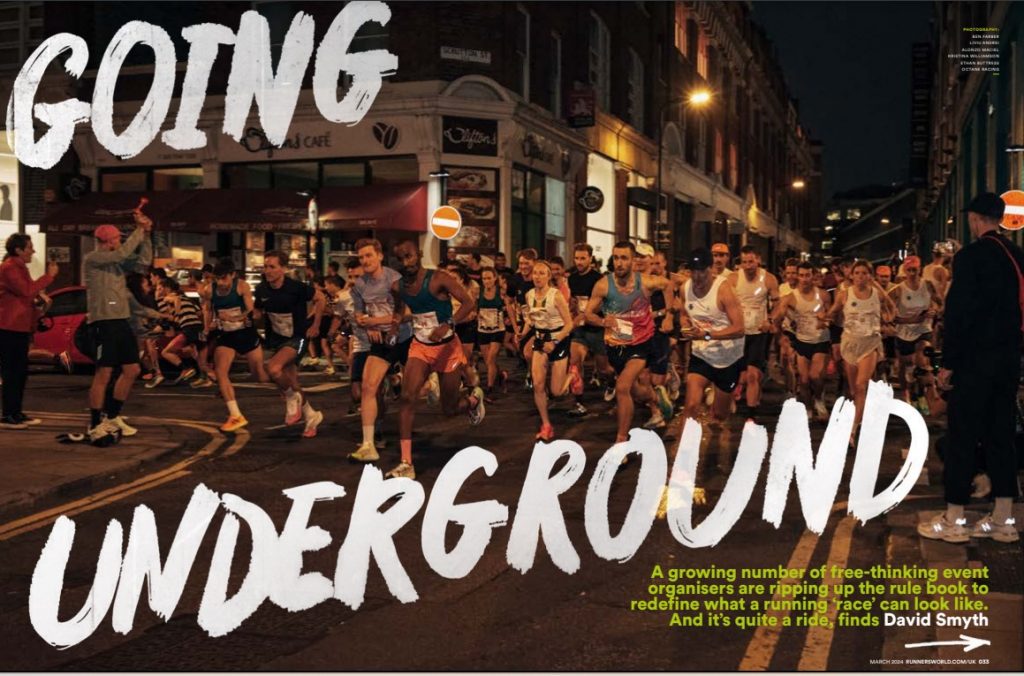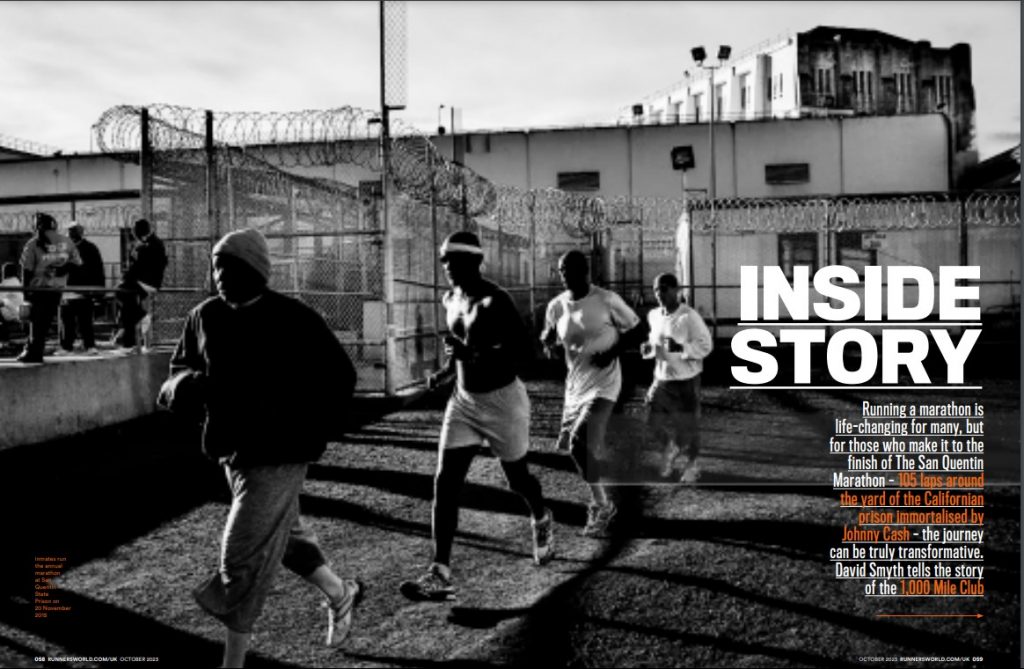A marathon doesn’t usually start in a pub. But that’s sometimes where they begin, years before the inaugural bang of the starting gun.
In the case of two relatively new Sussex marathons – the Moyleman, which loops around Lewes and first took place in 2015, and Brighton, which has been the UK’s second biggest marathon since 2010 – the pub was where those first speculative conversations were had. Could this be done? Why hasn’t anyone done it before? Could we do it?
It’s a tale of two cities – well, one city and a market town. The two races couldn’t be more different. Brighton sees about 12,000 runners trotting along the famous seafront, cheered on by a further 60,000 in an event that rivals Pride and the London to Brighton Bike Ride as one of the largest events in the South Coast tourist destination’s calendar. In its fourth year, the Moyleman has grown from 90 participants to 350 and follows the trails in the hills surrounding Lewes, 10 miles east of Brighton, including a sizeable chunk of the South Downs Way. The spectators are mostly sheep.
Brighton began because two locals used their expertise to spot a gap in the running market. Tim Hutchings was a former GB runner with medals for 5000m at the European Championship and Commonwealth Games. He’s also a Eurosport commentator and had worked as the London Marathon’s International Coordinator for 10 years. Tom Naylor is Brighton born and bred, the son of parents who had long been active in local running events. They used to organise Brighton’s half marathon. His mum, Chris, is the current President of the city’s Arena 80 athletics club.
“They organised their first race when I was about seven, so I’ve had many years of stuffing race packs in the kitchen. That was just a thing we did in our family,” says Naylor. He competed as a high level club runner in 1500m and 5000m before going on to open a running shop in Hove. “Tim had seen the London Marathon change and grow hugely, and had also travelled the world commentating on running events and seen how many major cities across Europe have their own marathons. We couldn’t understand why London was the size it was, rejecting so many people in the ballot every year, while there was nothing else close to being that big.”
The Moyleman, in contrast, began as a less ambitious concept but has still grown to the immense satisfation of the local mates who thought it would be a fun thing to do. It’s named after Chris Moyle, a local runner who died from stomach cancer in 2009. The spot where his ashes are scattered looks down on part of the route. Its real genesis came, however, when Duncan Rawson, a keen mountain biker, met Ash Head, Moyle’s training buddy, in a pub, and enthused about his day spent riding a punishing lap around the local hills. He said he’d covered about 28 miles, which switched on a lightbulb.
Head wrote a blog outlining a speculative marathon route, saying: “This’ll probably never happen.” The reply came back from another friend and local runner, Tom Roper: “This MUST happen.” Rawson and Head now share the job of race director, while Roper is chief marshall. Two more friends, Rob Read and Brian Courage, handle PR and money stuff respectively. No one spends so much time on the organising that it ruins the experience, though Rawson still replies to every querying email personally, so the immediate run-up gets hectic.
“It ebbs and flows, the amount of time it takes up in our lives,” says Head. “Six weeks out, you might have nowhere near enough marshalls. Organising the roving 4×4 medical teams is a significant job. But the bar is set reasonably low. There’s not a lot that can go wrong. The thing we fear the most is people getting hurt, injured, lost.”
The Moyleman doesn’t require any road closures, and finishes in the deliveries yard of the helpful local brewer, Harveys. Instead of a medal, you get a branded pint glass, complete with beer, at the finish. The only piece of private land used requires verbal permission from a friendly local farmer, who they treat to dinner in a nice restaurant once a year.
Brighton Marathon, in contrast, completely takes over a significant chunk of the city. “It impacts everyone in different ways. For some people it’s a bit annoying. For others it shuts down what they’re trying to do,” says Naylor. “We’re dealing with an under pressure hospital. Bus routes, taxi routes, fire stations, car parks, all have to be considered. The Council were great – they wanted to do it. But it took a long time to get the route into position and make them confident that we weren’t going to ruin a lot of people’s weekend.”
Naylor’s and Hutchings’ company, Grounded Events, has eight employees who work on the Marathon all year round. But as race day approaches, that number ramps up considerably. They bring in 25 events professionals who have worked on big occasions such as the Olympics and the Tour de France, supervising a 200-strong events team. There’ll be about 500 stewards and security people across the event, as well as 150 medical volunteers – doctors and senior nurses – and 400 St John Ambulance first aiders. Plus about 1800 volunteers handing out race packs beforehand and managing drinks stations during the race.
Their race was popular straight away, attracting about 7,500 runners in its first year. Like Edinburgh, whose marathon had just over 6,000 finishers last year, it’s an attractive city to visit for a weekend anyway so has instant appeal. Brighton’s immediate success was also helped by the cunning decision to take place the week before London, hoovering up many who want to train through the winter and didn’t get into the big one.
Social media also helps these days, enabling them to publicise the race far more widely and quickly than putting an advert in the back of a magazine. “It’s created an experience market,” says Naylor. “People challenge themselves in a public way, and are inspired by seeing other people challenging themselves. Up to 70 per cent of people doing our marathon are first timers.”
But it has its downsides too. Complaints are aired more widely too. What kind of criticism has Brighton had? “Anything and everything! It’s somebody’s once in a lifetime experience, so anything that makes that the slightest bit negative – queueing, the loos, not liking the start location, hating the music – that feedback starts to come in immediately after the race has finished.”
So putting on a marathon is an evolving process – they’re still tinkering. The Moyleman organisers now have to put up their route arrows at the last minute in one village, otherwise they get taken down again by hostile locals. Brighton is experimenting with a start time 45 minutes later this year, to make it easier for participants who don’t live in the city. While they fiddle with this, as well as a slight route alteration and changes to the park and ride system, they’ve made the number of entrants a bit lower.
Yet both sets of organisers know that they’ve created something valuable, loved by many who come repeatedly, and have no desire to make their races much bigger or smaller. “Someone suggested a while back that we could make this the Sainsbury’s Moyleman. Over my dead body,” says Head.
“We like to be at the finish line and shake everyone’s hand,” says Rawson of the Moyleman’s low-key finale. “We never set out to make money. Watching people cross the line, the tears and the hugs, it’s incredibly emotional. That’s the real pay-off.”
TIPS FOR ORGANISING YOUR OWN MARATHON
IT’S NOT WHAT YOU KNOW
Through their backgrounds as high level runners and Tom Naylor’s experience running a small business, Brighton’s organisers already knew plenty of the key people to speak to about putting on a local marathon. Moyleman organiser Duncan Rawson’s background in farming got him access to the right fields.
BE PATIENT
It can take a few years for that initial pub idea to become a reality. The first conversation about a Brighton Marathon took place in July 2007 and it was licensed in May 2009. An unofficial Moyleman for 15 running friends took place the year before they did it for real.
ACCEPT YOUR MISTAKES AND IMPROVE THE NEXT YEAR
One of Brighton’s biggest problems was the year that the kit bags turned out to be too small and flimsy. Unfortunately they only discovered this when thousands of them arrived two days before the race. Needless to say it didn’t happen again.
HAVE FAITH IN PEOPLE
As a small race relying largely on local goodwill, the Moyleman can cut it fine to be completely ready. Marshalls often only emerge at the last minute, or have to be ferried from early in the race to near the end to man a second post. One year, in the absence of anyone else, a medic crew took over a water station for a while.
BE CHARITABLE
Without the investment of numerous charities, who receive their money back fivefold when people receive their allocated places and do sponsored runs, Brighton would struggle to operate. Although it doesn’t have any offcial charity involvement, the Moyleman gives any profits to Martlets, the local hospice that cared for the race’s namesake.















